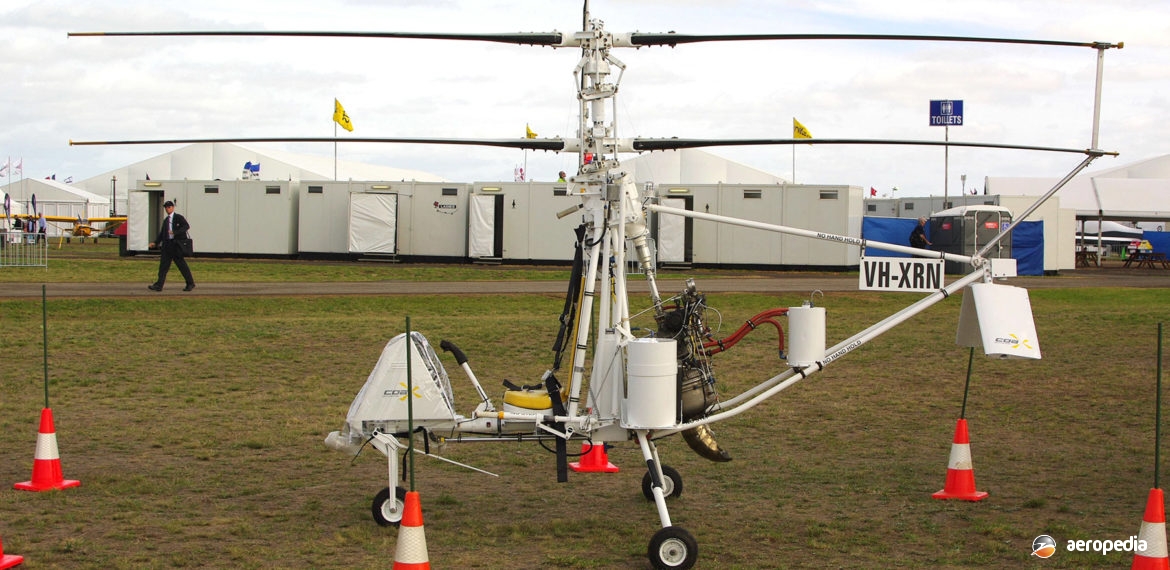Photograph:
Gyrodyne XRON VH-XRN (c/n 4008) at Avalon, VIC in February 2015 (David C Eyre)
Country of origin:
United States of America
Description:
Single or two-seat light helicopter
Power Plant:
One 54 kw (72 hp) Porsche YO-95-6 four-cylinder horizontally-opposed engine
Specifications:
- Length of fuselage: 3.5 m (11 ft 6 in)
- Rotor disc area: 29.18 m² (314.2 sq ft)
- Rotor diameter: 6.09 m (20 ft)
- Height: 2.74 m (9 ft)
- Width: 1.03 m (3 ft 4 in)
- Max speed at sea level: 109 km/h (68 mph)
- Cruising speed: 84 km/h (52 mph)
- Rate of climb at sea level: 299 m/min (980 ft/min)
- Max rate of climb at sea level: 543 m/min (1,780 ft/min)
- Service ceiling: 3,932 m (12,900 ft)
- Combat range: 79 km (49 miles)
- Max endurance: 1.12 hrs
- Empty weight: 195 kg (430 lb)
- Payload weight: 27 kg (60 lb)
- Loaded weight: 371 kg (818 lb)
History:
In the 1950s the United States Navy (USN) was seeking a cheap, simple, single-seat helicopter for the reconnaissance and assault role. To meet the requirement the Gyrodyne Company of America in St James on Long Island, New York, produced a series of helicopters known as the XRON Rotorcycle between 1954 and 1956. A series of designs was tested by the United States Marines (USM), and in the 1960s an un-manned derivative was produced in some numbers. The machines were very manoeuvrable.
Development of the XRON series continued over the years, being produced mainly for military operators, its roles including observation, liaison, and ‘small unit tactical manoeuvres.’ It was able to be folded to reduce its size for transport from point to point. It had two two-blade co-axial rotors of the semi-rigid type, these being of laminated wood construction.
The XRON was fully controllable through the contra-rotating rotors, control in pitch and roll being obtained through a conventional cyclic pitch control. Control in yaw was maintained by means of Gyrodyne developed rotor-blade tip-air (drag) brakes which provided positive directional control in all flight regimes. An inverted V-tail was utilised to provide longitudinal and directional stability in forward flight. Power plant was usually a Porsche engine modified by Gyrodyne, but in later years the Company made a number of improvements to the XRON main rotor transmission and indicated it would install a new engine.
Three examples of the machine were imported to Australia by Wieland Helicopter Company Ltd of Oatlands, NSW, these being known as the XRON Optimized, becoming VH-WIE (c/n 4009), VH-XRN (c/n 4008) and VH-YRN (c/n 4015), all registered on 4 March 2005. Little is known about these three machines. One was noted at Camden, NSW in September 2007 for the installation of an enclosed cabin but this conversion was not completed.
In May 2014 VH-XRN was noted on display at Helicopter Expo on the Gold Coast, QLD at that time being registered to Coax Helicopters Ltd of Parramatta, NSW, and reports from the event indicated the three aircraft were to be developed as un-manned aircraft. An example was displayed at the Australian International Air Show at Avalon, VIC in February 2015.

